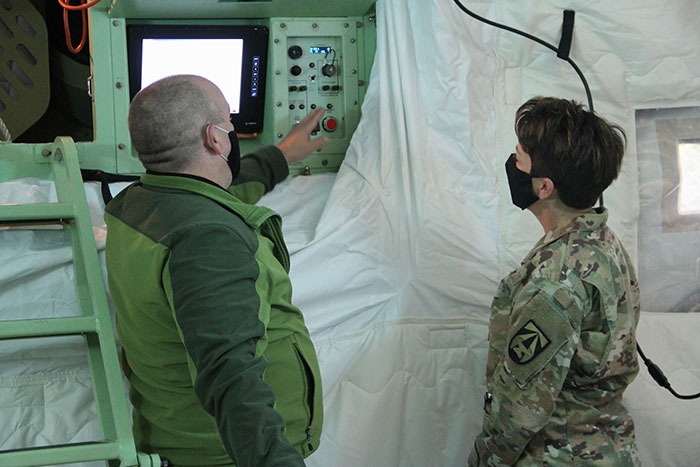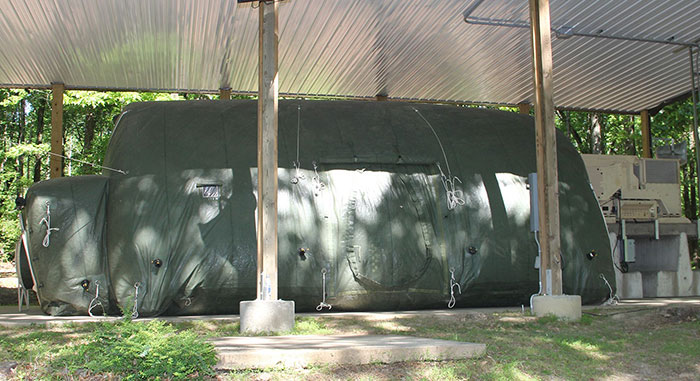Specially configured Chemical Biological Protective Shelter enhances USAMRICD training capabilities

The U.S. Army Medical Research Institute of Chemical Defense (USAMRICD), a direct reporting unit of the U.S. Army Medical Research and Development Command, added a unique asset to its training mission capabilities with the recent installation of a specially configured Chemical Biological Protective Shelter (CBPS). Installation of the CBPS marks the completion of a multi-year endeavor to equip USAMRICD's Chemical Casualty Care Division (CCCD) with this training-specific system. The USAMRICD is the first of what will eventually be only two locations to have a system designed for training purposes.
The CBPS was installed at CCCD's field training center and will be used to train medical professionals, combat medic specialists, and first responders attending the institute's Medical Management and Field Management of Chemical and Biological Casualties (MCBC and FCBC) courses.
"With this unique capability, the institute will be able to provide course participants with the training and experience to deliver health service support while in a collective protected CBPS system," says Daniel Boehm, a field medical education specialist in the CCCD.
The M8E1 CBPS is described as a highly mobile, easy-to-use, and self-contained chemical biological protective system. The shelter provides a contamination-free, environmentally controlled space in which forward deployed medical units and surgical teams can treat casualties in an area contaminated by chemical or biological agents without having to wear cumbersome protective clothing and equipment. The system's inflatable fabric shell is supported by a rigid frame and consists of ambulatory and litter entrances, both pressurized to decontaminate individuals before they enter the shelter. The CBPS system is integrated on a tactical vehicle to power the system's controls and facilitate its rapid deployment. The training units, however, are configured to be stationary.

The new system replaces the legacy CBPS that the CCCD had been using from 1999 until 2010, when it became no longer serviceable. In 2013 the Joint Project Manager CBRN Protection, under the Joint Program Executive Office for Chemical, Biological, Radiological and Nuclear Defense (JPEO-CBRND), offered to provide the USAMRICD with the new CBPS system at no cost to the institute, with the caveat that improvements be made to the institute's field training site. Suggested improvements included building an overhead pavilion to better protect the CBPS from the elements and adding a simulated vehicle platform on which to mount the shelter controls.
The CCCD worked with USAMRICD's Facilities and Logistics Offices to implement the necessary improvements. The simulated vehicle platform was delivered within five months, but the process to construct the pavilion was not complete until the spring of 2018. Once the pavilion was installed and configured, Boehm began working closely with the U.S. Army Combat Capabilities Development Command - Soldier Center in Natick, Mass., particularly with Gregg Buehler, the product manager for CBPS, to plan for their team to install the new system and to provide training to the CCCD staff. The installation was initially set for spring 2020, but the pandemic pushed those plans back a year to this May.
"The CBPS will enhance the experience of our training participants so that when they see it again in the field they will know how to incorporate it into their plan of action for the patients," said USAMRICD Commander Col. Robin Neumeier. "We are so grateful to our colleagues at the Combat Capabilities Development Command - Soldier Center for assisting us in securing this platform. This will be incorporated into future training programs at MRICD."
The installation team, consisting of Buehler and Timothy Kimball from the DEVCOM Soldier Center, Gregory Upperman from the JPM CBRN Protection office, and Nathaniel Jarrett, Clayton Ferrell, and Brandon Ward from the Joint Munitions Command, Pine Bluff Arsenal in Arkansas, took about a day and a half to set up the shelter. Following installation, the CCCD staff received training on operating and maintaining the system.














